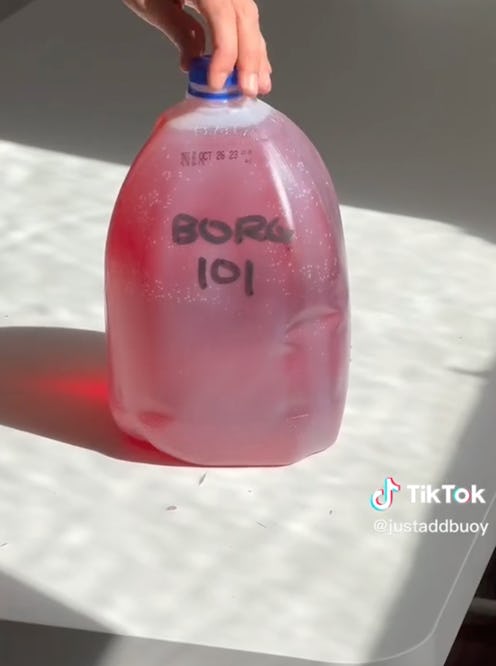Viral
What Is A BORG? Gen Z’s Go-To Drink Is Going Viral
There are actually some surprising benefits to it, too.
Even if you think about your time in college fondly, one thing you probably could’ve done without was jungle juice. Well, it looks like Gen Z has not only learned from our mistakes but is also upgrading the college partying experience with a new concoction called BORGs, which stands for “blackout rage gallons.” Yes, really. But what is a BORG, exactly? Though the name sounds like a bad hangover waiting to happen, Gen Zers have been showing off their fave version of the party drink on TikTok, and there are actually more benefits to BORGs than what meets the eye.
As you can probably tell by the name, BORGs are mixed drinks that are created in an empty water gallon — yup, gallon — before or during a party. But don’t worry, because the jugs aren’t filled with a gallon of pure alcohol. BORGs are most often made with a mix of water, vodka, and a flavor enhancer like Mio, Crystal Lite, or Kool-Aid. You can also add an extra chaser like seltzer or fruit juice, and for the pièce de résistance, you can add some Liquid I.V. to keep the hangover at bay. Allegedly.
Unlike jungle juice, there actually seems to be a method to the madness when creating a BORG. According to TikTok user @cooky_colin, all you need to do to make your BORG is:
- Grab a gallon of water, then pour out or drink half the water. (Given what you’re about to ingest, you should probably drink it).
- Pour a fifth of a gallon (or 17 shots worth) of vodka into the gallon.
- Add a flavor enhancer of your choice.
- Add Liquid I.V. (optional).
- Close the cap, and shake it around until it’s mixed.
Once you’ve made your BORG, it’s time to give it a name. Naming your BORG is a huge part of BORG culture, if you will, because it gives your drink a hint of personality while also making it easy to keep track of. You can name your BORG pretty much anything you want, but it has to be a play on the word “BORG,” like “internal borgans” or “cyborg.”
While it’s obvious that drinking a gallon of mixed drinks in one night is not the best idea, there are some positives to the whole thing compared to traditional jungle juice. For starters, BORGs don’t require you to drink from the same germy bucket as everyone else at the party. Instead, you can make yours how you want ahead of time. Plus, you don’t have to share it with anyone you don’t want to, which is a great option considering what the world has gone through over the last few years.
TikTok creator @justaddbuoy also pointed out there’s no way for others to tell if your gallon actually has alcohol or not. So if you don’t want to get drunk but don’t want to spend the whole night explaining why you’re not drinking either, you can make your BORG alcohol-free and still rage through the night. A gallon of Kool-Aid doesn’t sound half bad.
The fact that BORGs have caps is revolutionary as well because it makes it a lot harder for people to tamper with your drinks. Plus, the handle makes it super easy to carry, which means you won’t have to put down your drink as much to complete simple tasks like tying your shoe or texting your bestie the address.
TikTok user @erin.monroe__, who is credentialed in substance use prevention in New York state, called the Gen Z creation a “really solid harm reduction,” because the BORG allows people to make their own decisions about what they’re drinking, keep it in a closed container, and bring it everywhere they go. In other words, BORGs are just a cleaner, safer, and better version of jungle juice, and Gen Z is a lot more evolved than we give them credit for.
Like any alcoholic drink, it’s important to remember to pace yourself while drinking a BORG. Since it has a cap there’s no need or pressure to finish it all in one night, in fact, a gallon BORG can last you several nights out if you want it to. After all, it’s called a Black Out Rage Gallon for a reason, so make sure to drink responsibly and take breaks throughout the night as needed.
This article was originally published on
